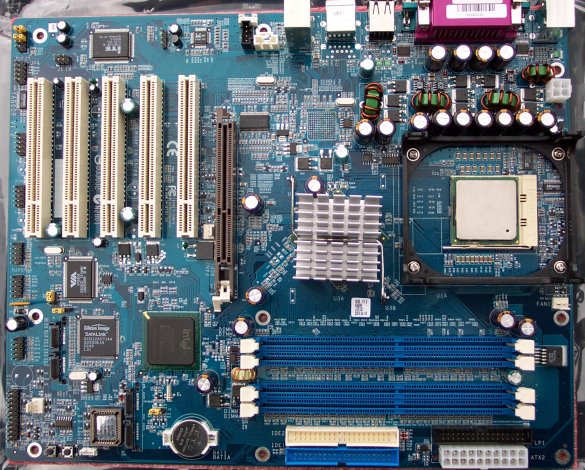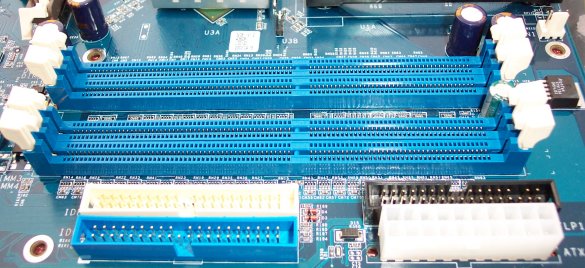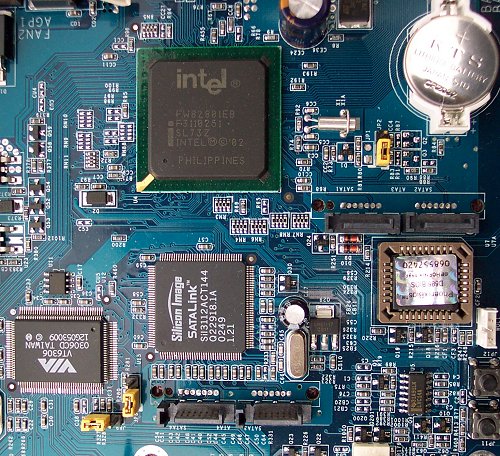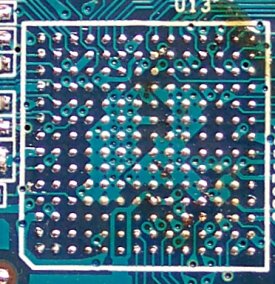Layout and features

Shuttle's trademark blue PCB provides the background to this decent-looking motherboard. On first glance, the motherboard's layout looks good. Lots of components located in sensible places. The AB60RS is a standard ATX motherboard, that is, it's 300mm x 245mm.

A couple of basic things to note here. Shuttle use a 4-phase power supply on this model. We've seen the majority of Shuttle boards make do with a 3-phase design. Taking a leaf out of ABIT's book, perhaps ?. The capacitors are from Rubycon, and provide 3300uF @ 10v. Secondly, and this may well be a personal issue, I do like the way that the retention bracket is held in. 4 screws go through to a plate on the back for secure attachment. This has two benefits. Firstly, the bracket is better secured than with the traditional plastic pin approach. Secondly, it's far easier to remove the bracket if you want to mount a larger cooler or feel the desire to watercool. The plastic pin approach is fraught with danger if you're using a screwdriver to lever out the pins and bracket.

Shuttle provide only one fan header by the CPU. We always like to see at least two for cooling purposes. The main 20-pin power connector sits in very close attendance to the floppy port. Thankfully, the floppy port locks in the other way around. There's a reasonable amount of space around the DDR slots to mount and dismount RAM easily. This is further helped by the 8x AGP slot being a slot further down the motherboard (the first PCI slot has been sacrificed and the AGP slot takes its PCB space). This allows one easy access to the RAM. Another benefit of moving the AGP slot down a notch is the ability to specify a large, passive Northbridge cooler. We're happy to see this, as always. We're not sure why Shuttle then decided to locate its right extremity so close to the CPU's retention bracket.

A bit of mixing and matching from Shuttle here. The ICH5's two S-ATA ports can be seen on the right-hand side, yet they're standalone (non-RAID) affairs. That job is handed over to the now ubiquitous Silicon Image Sil3112A S-ATA controller. It, too, is a standalone affair, and isn't a bridge unlike some competing solutions. Running off the PCI bus, it supports 2 S-ATA drives in either independent, RAID0 and RAID1 formats. It's ease of use and relative flexibility see it specified on a number of deluxe motherboards. That's been the case for some time now, even before S-ATA drives hit the retail market. The very bottom-right houses a couple of buttons. Invaluable to the reviewer and tester, these allow you to power and reset the motherboard without having to short out the usual pins. Extremely handy if you're testing outside the confines of a standard case.
Most of today's motherboards are very nearly jumper-less. Shuttle use a couple of jumpers to control the behavior of both S-ATA and FireWire controllers. We'd normally expect to find their switching within BIOS. The FireWire controller is the trusted VIA VT6306. This three-port controller is fully exploited by three FireWire headers just out of shot. You'd think that the newer VIA VT6307 was better, wouldn't you ?. Yet the latter can only power two ports. In fact, the very left-hand side (or bottom) of the board is home to 3 FireWire headers, 2 USB2.0 headers (a total of 4 ports) and a S/PDIF digital audio transfer header.


Realtek's ALC650 is present again. The ALC650 is an 18-bit full-duplex AC'97 2.2 compatible stereo audio CODEC. It natively supports full surround sound 5.1 configuration with a maximum of 6 separate or discrete channels (Left, Right, Center, SL, SR and Sub). It also supports S/PDIF out, which is provided via a header. Shuttle, once again, fail to provide the necessary bracket to connect the header up to either optical or coaxial jacks. You might be bemused as to why there's a picture of missing controller. The AB60RS is specified with various forms of LOM (LAN on motherboard). However, due to a number of technical difficulties, review samples weren't outfitted with the various controllers. We are assured that retail boards will feature the appropriate chip and LAN port. We have no reason to believe that this won't be the case.

About the only visible omission is the LAN port. 4 USB2.0 ports are always nice to see. A 6-pin FireWire port would have been a nice addition. It seems that manufacturers are shying away from IDE RAID. Up until a month or so ago almost every deluxe motherboard featured either a Highpoint or Promise IDE RAID controller and ports. S-ATA RAID, quite understandably, seems to be all the rage now. We take this as a sign that IDE RAID's days are numbered, and that number is rapidly decreasing.
A clean, well thought-out implementation from Shuttle.









